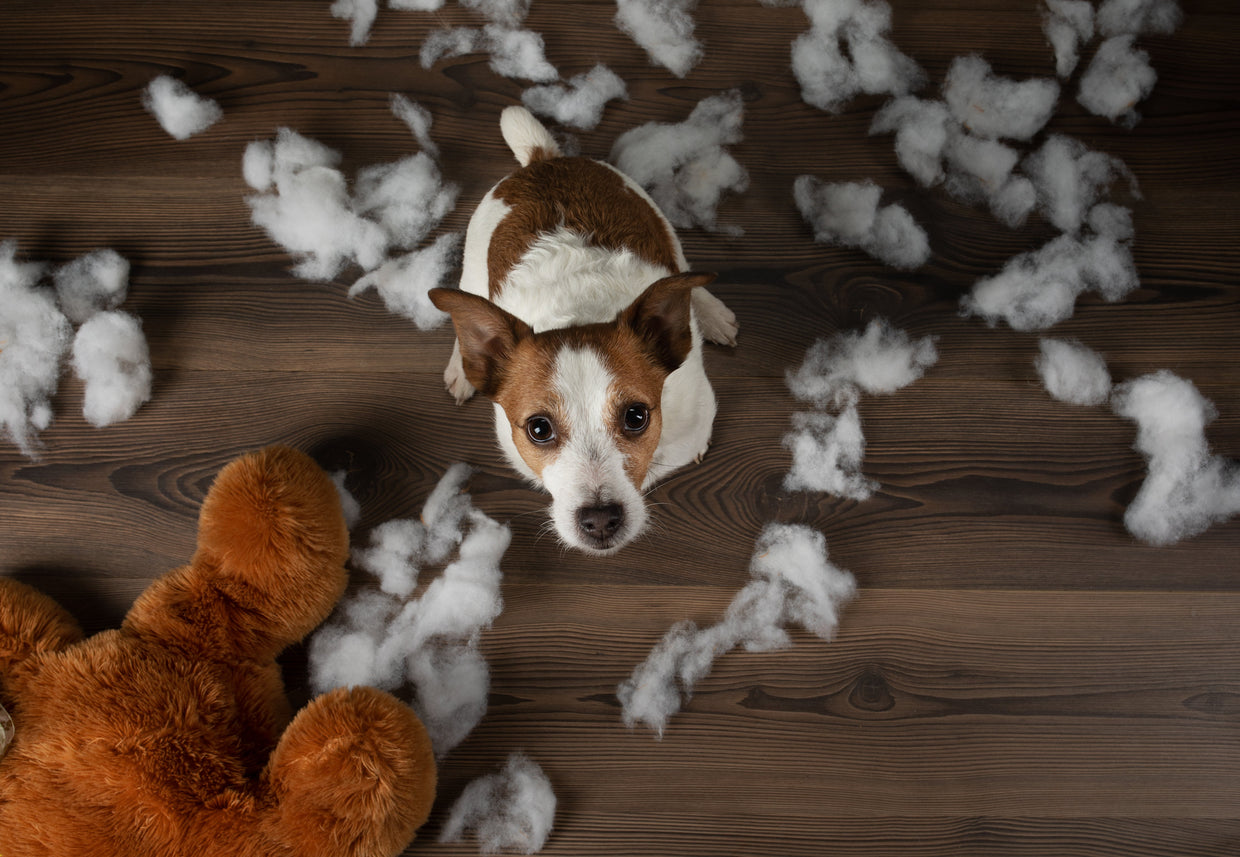

Do dogs have tantrums?
Answer: When something doesn’t go their way, toddlers (and some adults) are prone to tiny fits of rage – otherwise known as tantrums. But does your dog throw tantrums, too? Or have we simply humanised them to the point where we truly think of them as little people?
The truth is, your butter-wouldn’t-melt canine companion is more than capable of throwing a tantrum when they’re frustrated. Some examples could be when you don’t let them greet another dog, when you take away their toy or simply when you’re not giving them enough attention. It really can be as straightforward as that - perhaps calming supplements for dogs can help.
Signs of a doggy tantrum
- Refusal to move
- Whining, barking or growling
- Stomping and sighing
- Throwing themselves onto the floor
- Destroying furniture
- Too much excitement
Reasons for ‘tantrums’ and how to calm down your stroppy dog
1. You put on their lead
Some dogs hate leads, harnesses or any form of restriction. As soon as you put one on them, the bad temper is unleashed – literally! They might throw themselves onto the floor, bite the lead, or in the worst cases, bite you. Your immediate reaction might be to let go of the lead. But, by doing so, your dog will start to think that throwing a tantrum will get them what they want.
How to keep them calm:
Keep the lead taught and wait for your dog to calm down. It’s important to never raise your voice, and to stay as calm as you can. Repeat this every time your pet throws a tantrum to do with the lead. This way, they’ll quickly realise they need to be calm.
Here’s a few steps you can take to train your dog to love their lead:
- Take your dog outside to the garden or a field, and let them run for a bit
- Call them back to you
- Ask them to sit
- Put on their lead while giving them a treat
- Take the lead off and let them run around again
- Repeat
- By giving your dog a treat as you put a lead on them, and by letting them run free after taking the lead off, they’ll soon start to associate it with only good things.
2. Dogs don’t like being held
Some dogs love nothing more than throwing tantrums when you try to pick them up or hold them.
How to keep them calm:
- Hold them as quietly as you can, don’t say anything, and definitely don’t shout at them
- Wait for them to calm down
- Once they’ve settled, praise them and give them a treat
- Let them go
- Repeat this a few more times
This way, your dog will start to learn that being calm will get them what they want – attention and treats!
3. Barking for attention
Picture this: you haven’t seen your friends in months, and now you’ve finally got the chance to sit down with a cup of coffee. But your needy dog isn’t happy to no longer be the centre of your universe. They keep barking and barking and barking. You try everything to stop them, but nothing’s working.
How to keep them calm:
- When you’re alone with your dog, try to provoke their barking
- Once the barking starts, completely ignore your dog and carry on with what your daily tasks
- After they stop barking (this could take 10 seconds or 10 minutes), issue the ‘quiet’ command in a stern voice. It doesn’t have to be ‘quiet’, you can use any word or phrase you want.
- Give a treat along with the command, as well as some attention and praise
- Repeat this with every barking session
- After a few days’ practice, instead of waiting for them to quieten down, use the command while they’re making noise. Say the word only once. At this point, your dog will hopefully associate your command with being quiet and the treat that awaits them.
- Reward them with a treat and some attention
Eventually, you can start giving this command to control your dog’s boisterous barking when they want your attention. What’s more, you can use this command in other situations, like stopping them from barking at other dogs, to silencing the howls when the doorbell rings.
4. They hate being bathed – or they love it
Washing your dog can often turn into a complete mess if they hate bath time. If you’ve ever found yourself trying to catch a wet and soapy dog, then these helpful hints are for you!
How to keep them calm:
- Keep everything nearby. Leaving the bathroom gives your dog the opportunity to make a dash for it.
- Bribe them at bath time. Have your dog’s favourite treats nearby to reward good behaviour.
- Make it comfy. Provide a non-slip bathmat to give your dog better footing. And keep the temperature lukewarm.
- Don’t rush it. Slowly acclimatise your dog to water with walkies in the rain, trips to the beach and washcloths.
Want to learn more? Our comprehensive guide covers everything you need to know when it comes to bathing your dog.
5. They want to stay on their walkies for longer
When it comes to home time after a day at the park, your dog might be reluctant to leave. But how do you get them to listen to you?
The main reason behind your dog’s ‘tantrum’ in this case, is that they’ve learnt that coming back when called ends the fun. Your dog associates being called with the ‘punishment’ of going home. Try the following tips to combat this behaviour.
How to keep them calm:
- Do some surprise recall drills. And reward your dog with a treat, toy or attention when they come back to you. This teaches your dog that being called isn’t always bad
- Call your dog to you in a variety of locations, both on and off-lead
- Bring your dog back, then let them go again. ‘Reward’ them with more free time after they obey your recall.
All of this will teach your dog that coming when called doesn’t always mean something bad, like going home. Sometimes they’ll get treats, and sometimes they’ll get to run about for even longer!
Other top tips to stop dog tantrums

Make sure all of their needs are met
Your dog might be acting out simply because they’re bored. Take them on plenty of walkies and give them enough stimulating toys when you’re not around. Think puzzle toys, chewies and Kongs.
Issue a stern command
This is perhaps the most effective way to snap your dog out of their temporary craziness. The second your dog starts to act out, give an authoritative, "sit", "stay" or whatever command you want. Your dog is likely to still listen to you even when they’re throwing a tantrum.
Walk away
If your dog’s tantrum is caused by external stimuli – like other dogs or people – commands probably won’t work. Your dog will be too focused on their distraction to pay attention to you. If this is the case, simply turn around and walk the other way.
Keep them still
Hold your dog with a firm grip until the frenzy ends. Otherwise, they’ll think that their bad behaviour gets results.
Note: This one only works with puppies and small dogs. As you can imagine, trying to hold down a 40kg German Shepherd mid-tantrum isn’t the best idea!
Keep calm yourself
Raising your voice or hovering over your dog will likely worsen the tantrum. Other advice you may have read online – like pinning your dog onto their back, tapping their nose, spraying them in the face or physical discipline – will only make things worse.
Note: If your dog tries to bite you during a tantrum, stop or refrain from touching them. A qualified behaviourist is best placed to help in this situation.
Does your dog often throw temper tantrums? Visit our Facebook and Instagram pages and let us know how you usually get them to calm down.





